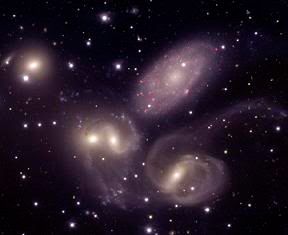Post by glactus on Feb 8, 2009 20:38:45 GMT

Stephan's Quintet
Stephan's Quintet is a visual grouping of five galaxies of which four form the first compact galaxy group ever discovered. The group was discovered by Édouard Stephan in 1877 at Marseilles Observatory.
Stephan's Quintet is in the constellation of Pegasus. Distance from Earth is 300 million light years, and magnitude 14.8
The brightest member of the visual grouping is NGC 7320 that is shown to have extensive H II regions, identified as red blobs, where active star formation is occurring.
More recently known, these galaxies are of interest because of their violent collisions. Four of the five galaxies in Stephan's Quintet are on collision courses with one another.
The NASA Spitzer Space Telescope revealed the presence of a huge intergalactic shock wave, shown by the magnificent green arc in the picture to the right produced by one galaxy falling into another at millions of miles per hour. As NGC 7318B collides with NGC 7318A, gas spreads throughout the cluster, atoms of hydrogen are heated in the shock wave, producing the green glow. The molecular hydrogen seen here is one of the most turbulent formations of molecular hydrogen ever seen.
Most notable is the fact that this collision can help provide a view into what happened in the postulated beginning of the universe some 14 billion years ago.
Also of interest, NGC 7320 indicates a small redshift, while the other four exhibit large redshifts (near 6600 km/s). Since galactic redshift is proportional to distance, NGC 7320 is only a foreground projection and is 39 million ly from Earth versus the 210-340 million ly of the other four.
Credits: This is a NASA/ Spitzer image


